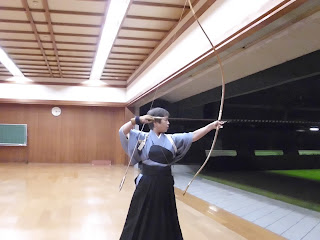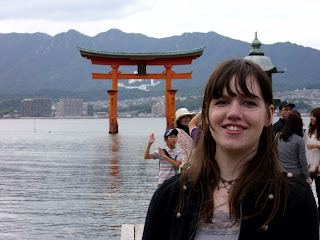Nara is known for it's shika (deer). Yes, that's right - deer. Small, dog-like creatures that follow people around begging for food, headbutting them for attention, and in return allowing themselves to be pet, coddled, combed, washed, and bred for the local entertainment. I'm a fan, personally. I mean, look at this gorgeous creature chomping away at carefully prepared deer food (which is sold for a reasonable price nearby because they just can't keep people from feeding the "wild" animals and probably figure this is better than PB&J). Note that I don't even think the deer is actually awake.

He's also not alone. Hundreds of these deer travel in herds around the local parks, and I'm told you can discern which herd a deer belongs to purely by how fat they are - fatter deer live in the more frequently traveled tourist areas. There were a number of babies around, many females, and a few males - horns neatly removed - discernible by their thicker, longer coats. The deer lose their spots in the winter, when their winter coats grow in, but this is as big as they'll grow. Like I said, dog-sized.
The ground is covered in deer droppings, of course, since there are large numbers of deer eating large amounts of food all the time in all the local parks. However, fear not! The local authorities vaccinate, worm, and otherwise care for the deer, so petting and or allowing them to eat food directly out of your mouth should not result in any serious communicable diseases. By the way, the headquarters for deer care in Nara is this building:
A non-descript building with no clear purpose unless you know what it is, I must say. I think it's wonderful that they take care of the wildlife, if they know that people are going to approach the deer anyway. As for why they take such good care of them - the deer are messengers of the local kami (deities). Eating or harming the deer in any way would be a grave offense, and in fact, caring for them is the proper answer (so feed them lots of senbei - deer food - and the kami will be happy).
Now for the picture line-up. This is a five story pagoda that is one of few remaining parts of the larger local temple. All of the areas were burned down multiple times in inter-temple disputes (ah yes, the peaceful past of Japan filled with its warrior monks and political sects) and most of which were finally no longer rebuilt (it costs a lot to rebuild these things over and over). The structure on the top is a dew catcher, if I remember correctly, and differs in design for each temple around Japan.
This is part of the same structure. It was possible to pay to enter and see the riches of the temple, but it was fairly expensive. The pagoda was, as are all pagoda, supposedly, empty. Many are built over sacred objects not meant for the common human eye.
Wandering farther down the path brings one to this "octagonal building" which I hear was quite extraordinary on the night of the tsunami, with the wind howling through the eaves and ringing the gong:
I rang it, too, for good measure, and dropped in a 5-yen coin. There was also a nearby massive bell that I desperately wanted to ring, mostly because it had a sign reading something along the lines of "Don't ring temple bells" which really said nothing about that particular bell....

This prayer gong was present at the building next to the other pagoda, just for comparison. It was much taller, and slightly more popular. I am not sure precisely what deities were present at the respective shrines. Anyway, wandering behind the octagonal building, the sounds from the open grounds nearer the more famous pagodas instantly faded into a comfortable silence. The shade of the local hardwoods spread and encompassed the path, shivering as their leaves whispered softly in the breeze. There, nestled among these trees, was a picturesque little three-story pagoda. Compared to its larger, more impressive counterpart, it seemed somehow finely built and strangely feminine. While the other pagoda was "impressive" this one could only be called "cute." I was asked which I liked better, but I really feel they were not comparable.

Leading away from the quaint pagoda was a path to the local love shrine, which I hear may have once been larger before it was reconstructed as it lost popularity, becoming a small, corner shrine on a busy street. It was closed when we came by, so we peered through the gate at the leaf-strewn grounds, enjoying the usual charged atmosphere of the "love" shrines.

Across from the love shrine was a crowded city street down which cars, bicycles, and people ran willy-nilly. The most difficult part of navigating Japanese streets is most likely the fact that many seem to not be marked off as specific to pedestrian or vehicular travel, particularly in the shopping districts and festival areas. My friends and I simply wandered across the streets, while cars crawled slowly through the even more crowded regions. I have found, however, that drivers seem to sometimes take the same view as bicyclists - if I go faster, I can squeeze in between. The result is simply drivers speeding at 80mph down quiet residential streets. I'm not so sure that is the proper outcome, but it may be unavoidable, all things considered. However, nowhere but in Japan does natural meet civilized in quite so jarring a fashion. Directly across from the crowded shopping district was this beautiful lake:

Closer examination found it to be filled with tiny fish and snapping turtles (though they were all hibernating for the winter, according to a local who stopped by for a brief chat).
The white specks are bread, I believe, which the hundreds of thousands of tiny fish were happily enjoying.
And this was the other side of the lake. It was not that big, but it was very beautiful, like a mirror to the sky. I will leave you with that image for now, and go to worry over my packing...how many layers of clothing must I wear to make 50 lbs, I wonder...




























































